AMD Carrizo Part 2: A Generational Deep Dive into the Athlon X4 845 at $70
by Ian Cutress on July 14, 2016 9:00 AM ESTStock Comparison: Linux Performance
Built around several freely available benchmarks for Linux, Linux-Bench is a project spearheaded by Patrick at ServeTheHome to streamline about a dozen of these tests in a single neat package run via a set of three commands using an Ubuntu 11.04 LiveCD. These tests include fluid dynamics used by NASA, ray-tracing, OpenSSL, molecular modeling, and a scalable data structure server for web deployments. We run Linux-Bench and have chosen to report a select few of the tests that rely on CPU and DRAM speed.
All of our benchmark results can also be found in our benchmark engine, Bench.
C-Ray: link
C-Ray is a simple ray-tracing program that focuses almost exclusively on processor performance rather than DRAM access. The test in Linux-Bench renders a heavy complex scene offering a large scalable scenario.
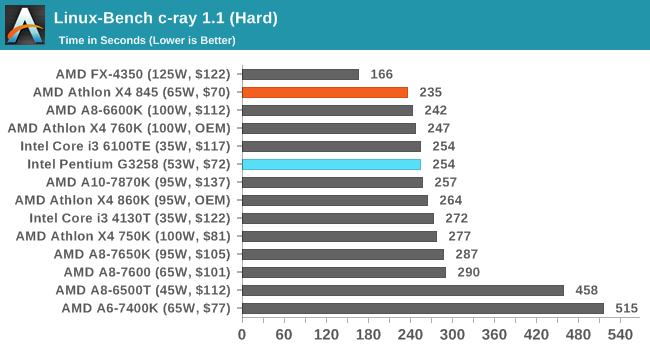
When we push up to full speed, the X4 845 comes alive and beats all the other Athlon CPUs (which wasn't the case at 3 GHz). It also pushes above the Pentium.
NAMD, Scalable Molecular Dynamics: link
Developed by the Theoretical and Computational Biophysics Group at the University of Illinois at Urbana-Champaign, NAMD is a set of parallel molecular dynamics codes for extreme parallelization up to and beyond 200,000 cores. The reference paper detailing NAMD has over 4000 citations, and our testing runs a small simulation where the calculation steps per unit time is the output vector.
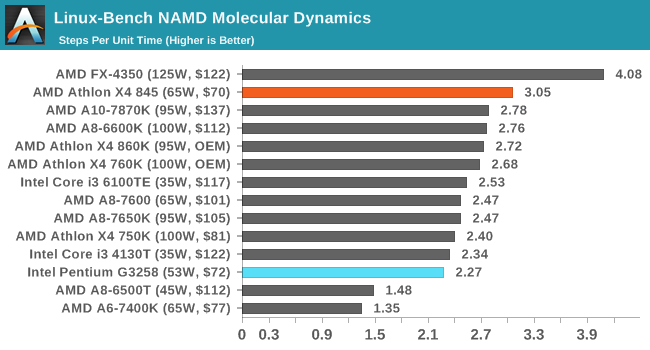
Similar things happen with NAMD.
NPB, Fluid Dynamics: link
Aside from LINPACK, there are many other ways to benchmark supercomputers in terms of how effective they are for various types of mathematical processes. The NAS Parallel Benchmarks (NPB) are a set of small programs originally designed for NASA to test their supercomputers in terms of fluid dynamics simulations, useful for airflow reactions and design.
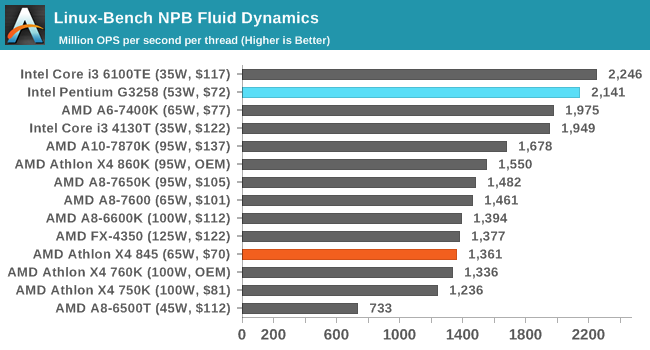
NPB seems more amenable with Intel CPUs in this case. I feel the cache arrangement in the X4 845 is the let down here again.
Redis: link
Many of the online applications rely on key-value caches and data structure servers to operate. Redis is an open-source, scalable web technology with a strong developer base, but also relies heavily on memory bandwidth as well as CPU performance.
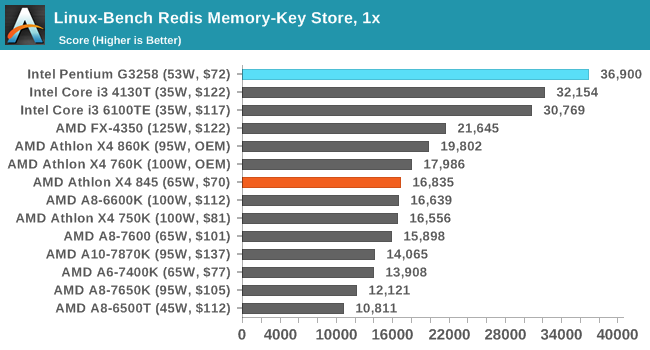
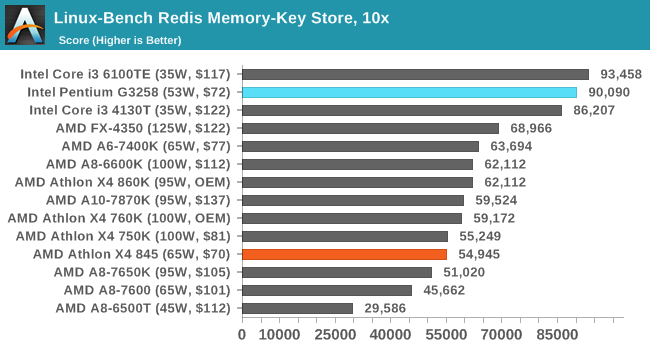
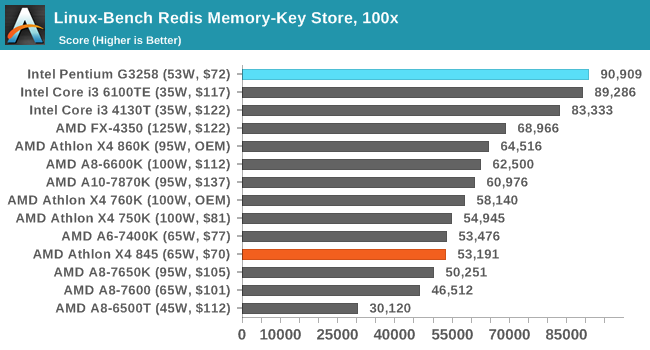
Redis easily favors high speed caches, and the Pentium oozes performance in this case.










131 Comments
View All Comments
artk2219 - Thursday, July 14, 2016 - link
They had too many parts that weren't hitting their mobile TDP's, or they just bakes too many chips than was needed on the mobile side. Either way, why let them sit in a warehouse or toss them at a loss, when for a very smalla mount you can just throw them into your standard desktop package and make some extra sales.TheinsanegamerN - Thursday, July 14, 2016 - link
Carrizo and kaveri did not use hypertransport. They would have to re-engineer their chip to work on AM3+, and to be frank, the AM3+ market is just too small to justify the tiny margins they would get.That money is better spent on getting zen out of the door.
neblogai - Thursday, July 14, 2016 - link
Why invest into upgrading bad product, when you can sell the same Bulldozer cores till Zen comes? And this Carriso Athlon is just a by-product of a mobile part and can only be sold for desktop. It all makes sense financially. By the way, new Bristol Ridge AMD 15W APUs are really nice and competitive, but laptop manufacturers are failing again- for example, HP Envy x360 comes with FX-9800P APU- again in single channel memory memory configuration, also with HDD installed and without possibility to use SSD. https://hardforum.com/threads/unboxing-1st-impress...TheinsanegamerN - Friday, July 15, 2016 - link
AMD doesnt take the mobile market seriously. If they did, they would be partnering up with the likes of MSI or clevo to produce a good laptop line for their APUs, or at the very least make dual channel a strict requirement.The_Countess - Tuesday, July 19, 2016 - link
AMD unfortunately can't demand much of anything from OEM's currently.and as intel still has a defacto monopoly no OEM wants to piss of intel by making a better AMD laptop.
nathanddrews - Thursday, July 14, 2016 - link
So... will there ever be a desktop Carrizo w/IGP? Much of the hype around Carrizo was focused on its very low power video playback, including H.265 hardware encode/decode.stardude82 - Thursday, July 14, 2016 - link
Isn't that what Bristol Ridge is? But on the new AM3 socket.Arnulf - Thursday, July 14, 2016 - link
AM4.Pissedoffyouth - Thursday, July 14, 2016 - link
Why not bang 8 of these cores into a 125w TDP and make it for FM2+ or AM3+? Finally an upgrade for Piledriver on AM3KAlmquist - Friday, July 15, 2016 - link
If you compare the Athlon 845 with the FX-4350 (link below), the Athlon wins on some benchmarks and loses on others. The Athlon has better IPC, but the FX has a faster clock and a 3rd level cache, leaving no clear-cut winner. If we added an L3 cache to the Athlon chip, that would speed it up, but not by a lot. In other words, Excavator is a big improvement over Piledriver in terms of performance per watt, but not much in terms of absolute performance. An Excavator based FX chip (by which I mean a chip with 8 Excavator cores and 8 MB of L3 cache) would probably be a very marginal improvement over the existing FX lineup at stock frequency, and would have less overclocking potential. I can see why AMD decided not to spend the resources to develop such a chip.http://www.anandtech.com/bench/product/1684?vs=127...